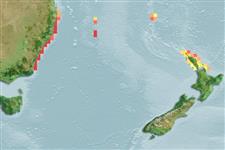Environment: milieu / climate zone / depth range / distribution range
Écologie
marin; saumâtre; profondeur 0 - 20 m (Ref. 6390). Temperate; 28°S - 37°S
Southwest Pacific: eastern Australia from Moreton Bay, Queensland to Eden, New South Wales, including Lord Howe and Norfolk Islands.
Taille / Poids / Âge
Maturity: Lm ? range ? - ? cm
Max length : 39.8 cm SL mâle / non sexé; (Ref. 10988)
Épines dorsales (Total): 0; Rayons mous dorsaux (Total): 15-17; Épines anales 0; Rayons mous anaux: 17 - 20; Vertèbres: 56 - 58. Preorbital canal with a posterior branch. Relatively longer jaws, especially at larger sizes. Gill rakers usually 34 or more in the first arch and usually 27 or more on the second arch.
Found in sheltered bays, clear coastal waters and sometimes in estuaries (Ref. 27012). Generally herbivorous. Feed mainly on seagrasses and algal filaments (Ref. 26551, 27013). Eastern sea garfish also consume a high proportion of crustaceans (Ref. 27013). A schooling fish, found generally near the surface at night and close to the sea floor over seagrass beds during the day (Ref. 6390). They are being preyed upon by mulloway (Argyrosomus hololepidotus) and tailor (Pomatomus saltatrix), as well as coastal water birds. No studies have been reported on the spawning of this species (Ref. 6390).
Life cycle and mating behavior
Maturité | Reproduction | Frai | Œufs | Fécondité | Larves
Viviparous.
Collette, B.B., 1974. The garfishes (Hemiramphidae) of Australia and New Zealand. Records of the Australian Museum 29(2):11-105. (Ref. 10988)
Statut dans la liste rouge de l'IUCN (Ref. 130435)
Menace pour l'homme
Harmless
Utilisations par l'homme
Pêcheries: commercial; appât: usually
Plus d'informations
RéférencesAquacultureProfil d'aquacultureSouchesGénétiqueElectrophoresesHéritabilitéPathologiesTraitementNutrientsMass conversion
CollaborateursImagesStamps, Coins Misc.SonsCiguateraVitesseType de nageSurface branchialeOtolithesCerveauxVision
Outils
Articles particuliers
Télécharger en XML
Sources Internet
Estimates based on models
Preferred temperature (Ref.
123201): 18 - 23.4, mean 20.7 °C (based on 55 cells).
Phylogenetic diversity index (Ref.
82804): PD
50 = 0.5000 [Uniqueness, from 0.5 = low to 2.0 = high].
Bayesian length-weight: a=0.00257 (0.00115 - 0.00574), b=3.09 (2.91 - 3.27), in cm total length, based on LWR estimates for this Genus-body shape (Ref.
93245).
Niveau trophique (Ref.
69278): 2.6 ±0.25 se; based on food items.
Résilience (Ref.
120179): Haut, temps minimum de doublement de population inférieur à 15 mois (Preliminary K or Fecundity.).
Fishing Vulnerability (Ref.
59153): Low vulnerability (23 of 100).
